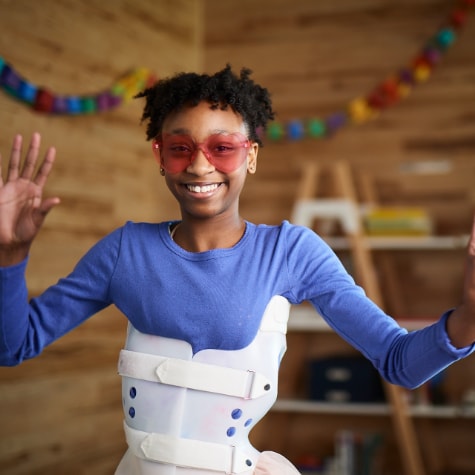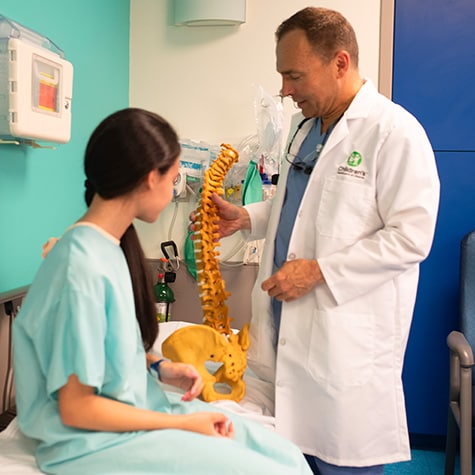If your child has been diagnosed with scoliosis or kyphosis, a doctor may prescribe a spine brace or spine cast. These are nonsurgical treatments that can stop or slow the growth of the spine's curve. Both of these techniques are beneficial in helping stop or slow a child’s scoliosis curve from progressing. Whether your child needs a brace or cast depends on her age, how much growing she has left and the degree of the scoliosis curve.
What is spine bracing?
Spine bracing is used to help prevent curves in the spine from getting larger as your child grows. Generally, curves less than 20 degrees don’t require treatment, since most do not worsen, but children whose curve is greater than 20 degrees and who will still continue to grow are candidates for either full-time bracing (approximately 16 to 23 hours a day) or night bracing. Braces do not make curves go away but may prevent the curve in your child’s spine from worsening. There is a wide variety of braces available, and your care team will help you determine the brace that best fits your child’s condition and lifestyle.

4 Tips for Wearing a Scoliosis Brace Comfortably and Effectively
Wearing a scoliosis back brace can be tough for kids, especially when they’re playing outdoors, on vacation or away at camp. With these smart tips from the Children’s Healthcare of Atlanta spine team, you can help your child wear a back brace comfortably and effectively.
Get TipsWhat is spine casting?
If your child is young and still has quite a bit of growing left to do, she is most likely to be diagnosed with early onset scoliosis, and a doctor may recommend spine casting over bracing. Since very young children grow so rapidly, wearing a corrective cast can reduce or correct scoliosis curvature.
Serial casting is a special technique that does not require an incision but does require anesthesia so that an orthotist or orthopedist team can apply a casting technique called elongation, derotation and flexion (EDF). This type of cast slowly reduces the size of the curve in your child’s spine over several months. This is usually an outpatient procedure. EDF casting can result in complete correction of the curve, or at least allow for bracing of a smaller curve. This procedure is typically reserved for preadolescent children younger than 5 years old.
Casting is not 100% effective for correcting scoliosis, but it may help slow the progression of a spinal curve and delay spine surgery until your child is older. This delay is important because the chest wall and lungs need to grow and mature before there can be surgery to correct your child’s curvature.
What to expect for your child’s spine casting procedure
- Your child will be put to sleep under anesthesia, but your child’s doctor will not make any incisions. Typically, kids are able to go home the same day that the doctor applies the cast.
- There is a specially designed table that helps your child’s doctor apply the cast.
- The cast will fit under the arms to the waist or over the shoulders down to the waist. This is based on where the spinal curve is located.
- The cast cannot be removed, is typically worn for three months at a time and is sometimes alternated with spine bracing to allow for periods of rest from the cast.
Spine braces are made of firm plastic and worn around the torso—the upper part of the body. The brace may also include foam padding for comfort or correction. Velcro straps hold the brace snug as your child grows. A seamless shirt is worn underneath the brace.
Your child’s doctor will determine what type of spinal brace works best for your child, depending on your child’s age and condition. Your child may have to be fitted for a new brace or switch to a different brace as she grows. At Children’s Healthcare of Atlanta, we offer the following types of spinal braces:
The Boston brace is the most common brace used for idiopathic scoliosis. It uses the hips as a base point and goes up to about your child’s shoulder blades.
The Boston brace was developed in Boston in the 1970s. At Children’s, we will take a digital scan or a cast of your child to custom make her brace to her body and curve. We will include 3D integrated corrective forces, foam pads or straps that straighten the spine while the brace is worn. Most children should wear the brace more than 16 hours a day—ideally only removing it for bathing, swimming and athletics. Studies have shown that wearing this brace for less than 12 hours a day is not likely to help at all.
The Rigo Cheneau brace has been offered at Children’s since 2018. Like the Boston brace, the Rigo Cheneau brace is most likely to be successful when it is worn the majority of the day and night. Within the brace, there are areas of corrective pressure and areas of void (no pressure) that are designed to restore balance to the spine in all three planes. The brace is designed by taking a series of measurements, a scan and pictures of the child. It is made of plastic, with padding added as needed, and it opens in the front.
Some patients, such as those with smaller curves or those close to being done growing, may benefit from nighttime-only bracing. The Providence brace is designed to be worn only while sleeping, so it does not limit daytime activities. It was first introduced in the early 1990s at the Hasbro Children’s Hospital in Rhode Island. Like the Boston and Rigo Cheneau braces, it is made of plastic, but it is fully lined with foam. The brace is optimized to be worn while lying down. Typical recommendations are to wear the brace between nine and 12 hours each night.
All spine braces are called thoracolumbosacral orthoses (TLSO) because they cover these areas of the spine. For patients with conditions other than idiopathic scoliosis, these other braces may be used:
- Custom flexible TLSO: The custom flexible TLSO is usually used after scoliosis surgery or by patients with neuromuscular scoliosis. It is foam with a plastic frame and is more flexible than other braces.
- Extension TLSO: An extension TLSO is used mostly for kyphoscoliosis, a musculoskeletal disorder. It can also be used for Scheuermann’s disease. It is designed to reduce kyphosis, or forward bending of the upper trunk as seen from the side. This type of orthosis is similar in design to the Boston brace, with the addition of a plastic and metal piece at the front of the chest to extend the spine.
You and your child may have questions as you get used to incorporating the brace into her day-to-day activities. Here are answers to some of the most asked questions the pediatric spine specialists at Children’s receive about wearing a spine brace.
Typically, your child can perform sports no matter how severe her scoliosis is. If your child wears an “all-day” brace, such as a Boston or Rigo Cheneau brace, we would typically recommend your child perform sports without wearing it. It’s important to consult your child’s doctor about any sport to help make sure it’s safe.
Your child will wear the brace until she is no longer growing. On average, this is about age 15 for girls and 17 for boys.
It depends on the type of clothes your child wears. With looser-fitting clothes, the brace will likely not be easy to see.
Because your child’s brace sits against her skin, it’s a good idea to clean the brace after wearing it all day. Cleaning your child’s brace with rubbing alcohol (either by misting it with a spray bottle or scrubbing it with a washcloth) is effective to keep the brace clean, and it dries quickly so your child can put it back on.

Our team created a private Facebook group for scoliosis families.
We know that the scoliosis journey can be a long one—from diagnosis and bracing through surgery and recovery. This page offers forums for asking questions, sharing tips and celebrating milestones with other spine patient families.
Start connectingContact Us 404-785-3229